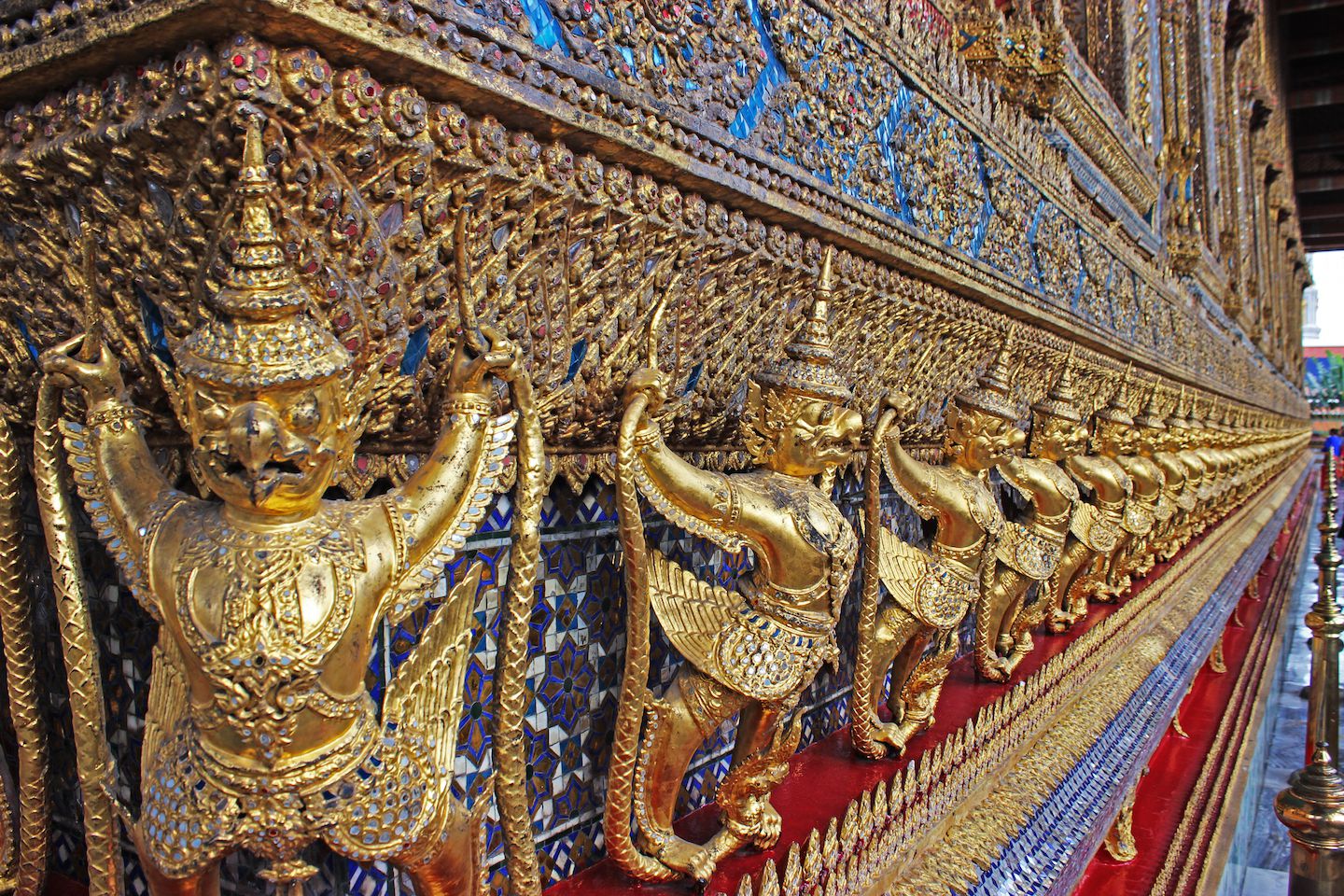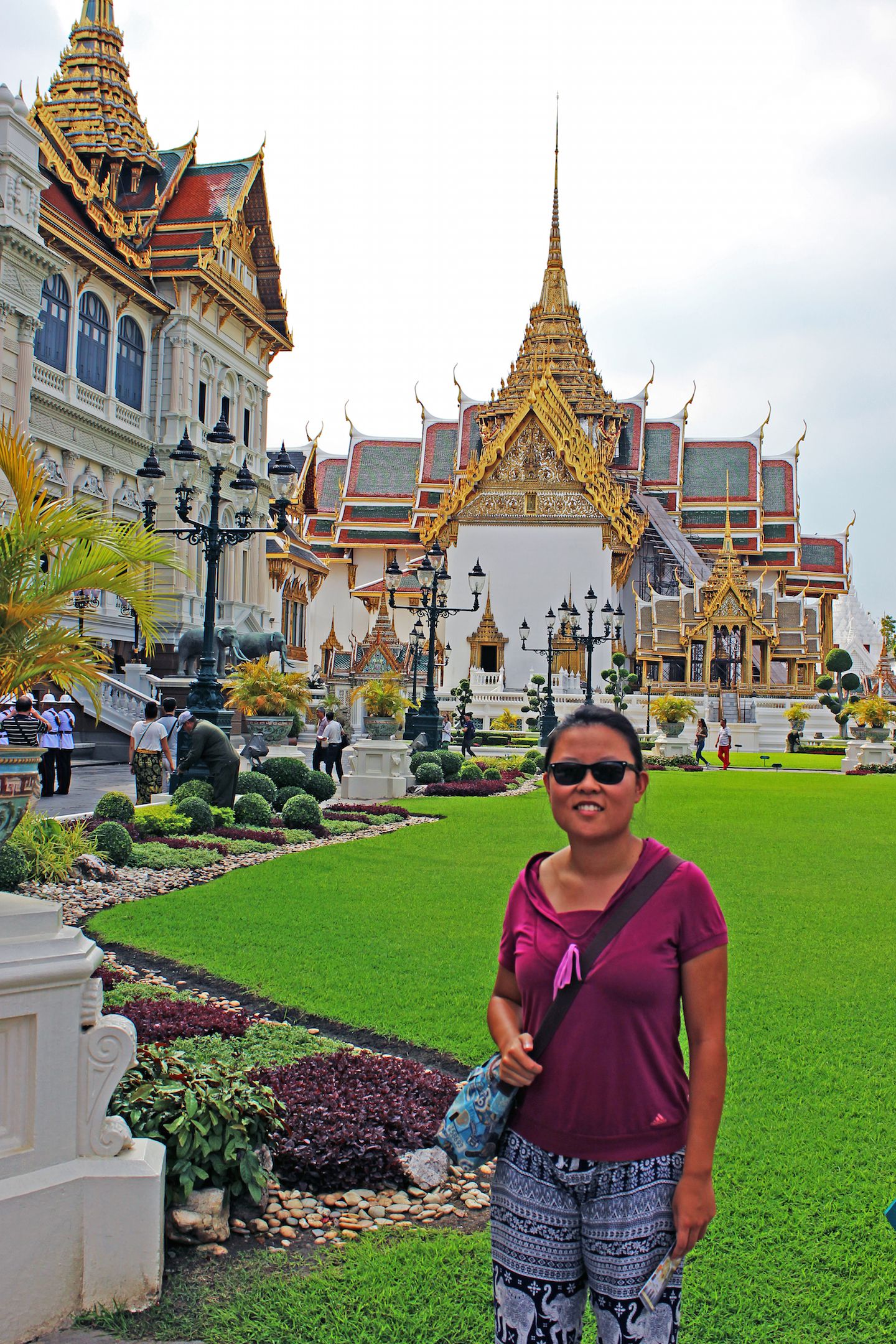Bangkok is a true metropolis and bustling capital in SE Asia, filled with everything anyone could ever dream of. We haven’t been in such a big city in so long, it was overwhelming to figure out where to live and what to do. Knowing this was the first of many stops in Bangkok and possibly one of the shortest, we opted to focus on the most historical part of Bangkok – on and around Rattanakosin Island. Most travelers will know this as the district where the infamous Khao San Road is located.

While we spent our nights on and around Khao San Road, we spent our days focused on the must-see attractions in the area – the most famous palaces and temples. This way we cover the basics of the most important landmarks in Bangkok this time, and our next visits can then be spent exploring other parts of the huge city as we wish.
Wat Pho
One of the oldest and most important temples in all of Thailand, Wat Pho was undeniably grand. There were over 1,000 Buddha statues in the temple, including what was probably the biggest reclining Buddha in the world.

We walked through the many buildings and sanctuaries that were part of the temple; however, while we thought it was beautiful, we were not absolutely blown away. This was probably due to the temple fatigue we began to experience after visiting countless temples since the beginning of our trip. It would have been very different if this was our first stop. Regardless, we tried our best to appreciate this sacred place to the max in the heat of Bangkok. The roof of the buildings looked really similar to the Khmer roofs, except these ones were finished with small porcelain pieces, which made them very shiny and pretty. We joked that it looked like Khmer roofs on steroids.

The skyline of the temple looked like a small city in and of itself, with multiple spires and roofs rising from the ground. The windows and doors were also intricately decorated with colorful images. All Buddha statues in the temples were stunning in their size and simplicity.

Wat Pho is also considered to be the birthplace of traditional Thai massage and thus was home to the Wat Pho Thai Massage school. We stopped by since Carlos was interested in taking a Thai massage course. The place was packed with tourists lining up for massages, so we just got the information we were looking for and got out of there.

All in all, Wat Pho was a spectacular temple complex. It just didn’t strike us due to outside factors unrelated to its own gradeur.
Wat Arun
Right across the river from Wat Pho was the temple of dawn, Wat Arun. We took the ferry (3 Thai baht per person) to cross the river. The ride itself was very short; however, it gave us the opportunity to experience boat travel in Bangkok, a common form of public transportation. The view of Wat Arun from the boat was nice, too. The main spire of the temple towered at 86m and is one of Bangkok’s most iconic landmarks.

From the ferry terminal to the temple itself, there was a nice garden with bonsais and yet another Buddhist temple. I think we admired the garden more than the side temple. Once we entered the grounds of Wat Arun, we had to climb some very steep steps up to the top.

The 360 degree, unobstructed view of Bangkok’s skyline from the top of Wat Arun was breathtaking. It combined both old historic structures, like the Grand Palace and Wat Pho, and new modern buildings, like Bayoke Tower II and the River South Tower. Only a place like Bangkok has elaborate temples and tall skyscrapers next to each other along a river filled with boats. I will never forget standing up there and gazing at the horizon.

Wat Arun also had noteworthy porcelain mosaic decoration with both Hindu and Buddhist figures. Demons and monkeys supported the main tower and at the top, the god Indra riding its three-headed elephant mount watched each cardinal point. The arrangement was very colorful and shiny, a definite contrast to the natural, faded stones of the temples of Angkor.

Grand Palace
It doesn’t get more Thai than the Grand Palace. The entire complex was huge, and every single part of it had its own significance. It’s easy to get lost in there as there were many paths between all the structures. The sheer number of tourists and the burning sun added more complexity to finding our way around the grounds. We will try our best here to summarize some aspects that stood out for us.

The most magnificent attraction in Bangkok, the Grand Palace exhibited the best of Thai architecture and showcased the wealth of the Thai kingdom. King Rama I ordered its construction in 1782, and it was used as the residence of the royal family until 1925. Upon entering the complex, a giant chedi (Thai-style tower) blinded us with its golden reflections.

Visitors were then directed to the Sanctuary of the Emerald Buddha, or Wat Phra Kaew – a large section of the Grand Palace ground. The main temple inside the sanctuary area housed the famous Emerald Buddha. Pictures were not allowed inside, but the Emerald Buddha was placed too high up and away near the roof of the sanctuary to have gotten a good shot anyway. We noticed that the Emerald Buddha had three different “outfits.” The one we saw, we joked, was his “winter” outfit, as it covered most of his body, a gold cloak covered in diamonds.

The outside of the main temple in Wat Phra Kaew was just as elaborate as the inside. A row of golden garudas holding nagas decorated the entire outer wall, along with colourful and shiny window mosaics. It was a feast for the eyes, bordering on overwhelming. That was consistent with all buildings within the sanctuary – it was as if someone took a bunch of the most decorated buildings in Thailand and put them all next to each other.

A few galleries led the way from the Wat Phra Kaew section of the Grand Palace ground to the rest, depicting images of gods and demons performing daily activities. The paintings were enhanced with metallic gold paint in certain places that shone in the sunlight, a stark contrast against the matte oil paint.

Exiting the galleries and entering the rest of the Grand Palace grounds, we felt like we had walked into a different place entirely. The architecture looked definitively more European, with columns and arches. Elephant statues were scattered on the façade – a Thai touch. A beautifully arranged and well-kept garden framed the front. There was finally room to breathe!

The next building open to the public was a throne hall. Inside, painters worked with tiny brushes to restore the painted walls. It was because of the restoration that we noticed the Buddha “wallpaper” was actually thousands of small identical Buddha statues, each of them individually painted. The steadiness, precision and patience needed for such an endeavour was unfathomable to me. Besides that, the outside of the throne hall was much more striking than the inside.

That concluded our walk through the stiflingly hot Grand Palace. By the time we got out, the entrance was swarmed with tourists and tour groups, there were people as far as I could see in every direction. We were relieved to get away from the crowds as well as get some fresh air. Subsequently, we sat in a nearby park looking at the Grand Palace skyline, reflecting on its resplendence.
We could not have asked for a better introduction to Bangkok than this. Before we left Bangkok this time, we squeezed in a visit to Dusit Palace, which really wowed us. Looking forward to being back in the near future!
For more pictures from Bangkok, please visit the gallery!

